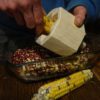Arkhipov White Dent corn
Price range: $4.00 through $15.00
(Zea mays)
This is a little experiment of mine. I wanted a white dent corn which would be full-season in my region, but could only find seed for varieties which were too long-season for me. I wanted it to be as vigorous as possible. So in 2023 I obtained seed for eight white dents in the United States. Six of them tasseled and silked approximately simultaneously, and I crossed them all with each other. This is the result. Expect some variability for the first few years, and select for what works best in your conditions! OSSI pledged.
– A slightly more fulsome explanation: What I am doing is making what the pros call a synthetic and the eccentrics call a grex (have fun figuring out which category I’m in!). Over time, I expect each succeeding generation to function more like a typical open-pollinated variety. The parents used for Arkhipov are:
From the National Plant Germplasm System: PI 251885 Kharkovskaya White Dent, PI 267184 Pioneer Dorski, PI 269748 Ozark White, PI 303856 Chesky Konsky Zub (Cze.), and PI 303860 Pcebendowska (Poland)
From Sand Hill Preservation Center: Rustler White Dent
I also grew PI 239571 (Samsun) from the NPGS and Rodrigo’s Northern Wisconsin-Adapted White Oaxacan from the Experimental Farm Network. Both matured substantially later than the others (they were also much larger plants). So I kept them out of the mix.
About the name: Vasily Arkhipov (Василий Александрович Архипов) was an executive officer in the Soviet Navy. In 1962, during the height of the Cuban Missile Crisis, he was one of three officers on the submarine B-59 off the coast of Cuba when it was cornered by American destroyers. The submarine had been operating deep enough that it had been out of radio contact with the USSR for several days, and so those on board did not know if war had begun or not. The destroyers began dropping signal depth charges on B-59 to encourage it to surface, and Arkhipov and his fellow officers had to decide: would they launch a nuclear torpedo? The other two said yes; Arkhipov said no. And here we are, still alive.
While not a great fan of navies, I admire a person who recognizes that sometimes one must go against one’s training and protocols to do what is right, and that it is often better to give one’s enemies the benefit of the doubt, even if they don’t give it to you. I think we need that in today’s world as much as in 1962. The parents of this corn are a mixture of two varieties from the United States and four varieties from the USSR which came to the US between 1958 and 1962, at the height of the Cold War. I find it heartening that even at that time there was still some flow of seeds between such deeply divided nations, because a core part of working with seeds is a recognition of our shared humanity – we all need food, therefore we all need seeds. I hope we can keep exchanging them across the lines which have divided us in the decades to come.
Wait until soil has warmed to 60° F/15º C to plant. Darker coloured seeds usually germinate better in cool soil. Plant 1-2” deep, four seeds to a hill (10” between them), spaced 40” on centre; or plant in rows 24” apart for early varieties, 30-40” apart for main season ones, with row spacing of 8-10” for early varieties and 10-12” for main season. Plants will pollinate for 2-3 weeks after tasseling; separate varieties by at least 500’ or plant successively so they will pollinate at different times. If doing succession plantings, let first variety reach eight-leaf stage before planting the next one. Save seed from at least 100 plants (preferably 200), selecting based on field characteristics of plant, not just on cob size.



